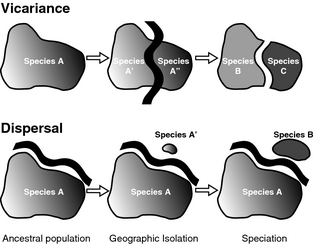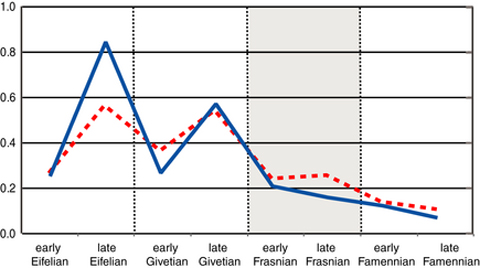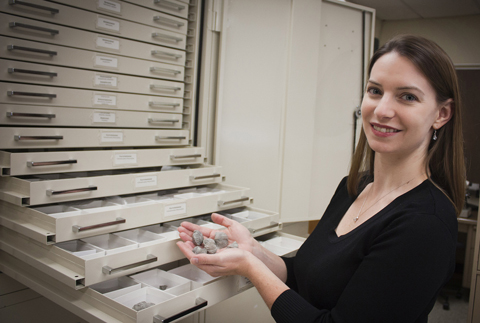Second in a Series on Macro-Evolution
Using the fossil record—and specifically a case of mass extinction about 374 million years ago—can help illuminate why “modern” macro-evolutionary theory is in need of modernization.
Darwin and his successors wrote the first chapters on evolution by looking at small changes in species over relatively short periods of time, usually described as natural selection. Scientists developed the Modern Synthesis to describe gradual evolution, and it has been the consensus in evolutionary theory for more than 60 years. (See It’s Time for a New Big Picture on Evolutionary Theory.)
Thinking of the evolution of species exclusively as “population genetics” is far too simplistic, says Dr. Alycia Stigall, Associate Professor of Geological Sciences. In a new article in Palaeontology, she argues for a broader evolutionary theory that accounts for large-scale environmental changes such as plate tectonics, sea level changes and climate change over periods measured by tens of thousands of years.
One of the Big Five Mass Extinctions
Stigall’s first case study involves one of the “Big Five” mass extinctions of the Phanerozoic—the geologic time period from about 542 million years ago to today.
She focuses on the development of new species of shallow marine brachiopods and bivalves that lived in the inland seas of Laurentia during the Late Devonian Biodiversity Crisis. This crisis is characterized by a dramatic loss of biodiversity, and it was also a time when tectonic pulses repeatedly sent seawater flowing over natural continental arches that had formerly separated the shallow seas.
Don’t think of this “mass extinction” just in terms of the number of species that disappeared. It was also a time when new species failed to appear.
Envision a number of relatively isolated ecosystems, each teaming with different species that have evolved isolated from other basins. Introduce plate tectonics that replaces these isolated basins with much bigger oceans of opportunity—and of challenges.
The eventual result is a smaller number of species spread over a wider area. With fewer discrete ecosystems comes fewer new species evolving, Stigall writes. The cyclical flooding of these tectonic continental arch barriers also promoted dispersal of invasive species over wider areas.
A closer look can provide insight into macro-evolutionary controls—such as local and global environmental changes—on speciation. Speciation is the separation of a set of organisms into a newly isolated reproductive unit (i.e., a new species) that is distinct from the ancestral species.

Figure 1. Geography of allopatric speciation modes. In vicariance, the geographic range of the ancestral species (Species A) becomes passively divided by a geographic barrier. Incipient species (Species A′ and A″) diverge during the interval of geographic isolation to become new species (Species B and C). In dispersal, a population of the ancestral species (Species A) actively migrates across a geographic barrier to form an incipient species (Species A′), which subsequently diverges to become a new species (Species B). Modified from Stigall (2012a).
More Important Than Warming and Cooling?
“The Late Devonian Biodiversity Crisis was a global event,” writes Stigall, “so aspects of environmental change in the Earth system were potentially key factors in contributing speciation dynamics.”
What was happening to the environment over this time period?
- Fertilization and changes in weather patterns over land affecting forest ecosystems
- Low-oxygen events within ocean basins
- Overall warming of the global oceans
- Pulses of enhanced carbon burial—and periods of rapid cooling
“Each of these environmental factors undoubtedly contributed to ecosystem degradation and extinction of certain species. Yet none of these supply a satisfactory explanation for speciation collapse because they do not directly impact the speciation process,” she writes. Two global issues, however, have been implicated in speciation decline:
- Widespread inter-basinal species invasions
- High-frequency sea-level changes

Figure 3. Middle to Late Devonian rates of biodiversity change. Speciation rate (solid line) and extinction rate (dashed line) calculated for species within two brachiopod (Schizophoria and Floweria) and one bivalve genus (Leiopteria). Speciation rates are substantially reduced during the crisis interval (shaded), but extinction rates are lower than during the Middle Devonian (Eifelian and Givetian Stages) background interval. Modified from Stigall (2010a).
Survival of the Generalists?
Before the waves washed into the shallow seas, ancestral populations of shallow marine brachiopods and bivalves were passively divided by land barriers and formed subpopulations that diverged to form new species, Stigall writes. This process is called vicariance.
But in the marine melting pot brought on by tectonic upheavals and pulses of sea level rise, geodispersal became the primary mechanism of biogeographic evolution, she says.
“Because speciation by vicariance typically occurs with higher frequency than dispersal, the near elimination of this mode of speciation would reduce the total speciation rate by 50 percent or more.”
Geodispersal favored species that were ecological generalists (eurytopic) rather than ecological specialists (stenotopic). So geodispersal also led to lower speciation rates as invader species that could survive in a wide array of environments replaced many of the more specialized native species.
“The suppression of Late Devonian speciation is not attributable to micro-evolutionary processes alone,” Stigall concludes. “Oscillations of sea level occur on timescales that exceed the lifespan of individual organisms. The frequency of species invasions and the greater relative abundance of eurytopic species in the environment relate to ecosystem and community structure, both entities in the economic hierarchy that are outside the scope typically considered in the standard Neodarwinian synthesis.”
Previously in the series: It’s Time for a New Big Picture on Evolutionary Theory
Upcoming in the series: Macro-Evolution: The Richmondian Invasion




















Comments